President Roosevelt’s Way Out
The mass exodus of Jews from annexed Austria creates a difficult situation for US President Franklin D. Roosevelt. Liberal and Jewish organizations call for the US to take in more refugees, but this is vehemently opposed by the Republicans, many Democrats in the South, and probably the majority of the American population. Meanwhile, the German-American Bund and racist groups agitate ever more aggressively against Jews.
An article by prominent journalist Dorothy Thompson in which she declares the refugee issue a threat to peace and thus “a world problem” opens up an opportunity for Roosevelt. After discussions with his cabinet and consultations with some European governments, at the end of March 1938 Roosevelt has Secretary of State Cordell Hull invite the governments of potential host countries to an international conference on refugees. The Roosevelt administration thereby forestalls initiatives in Congress to alter the requirements for the issuance of entry visas to enable the quota for refugees from Germany and Austria to be filled.
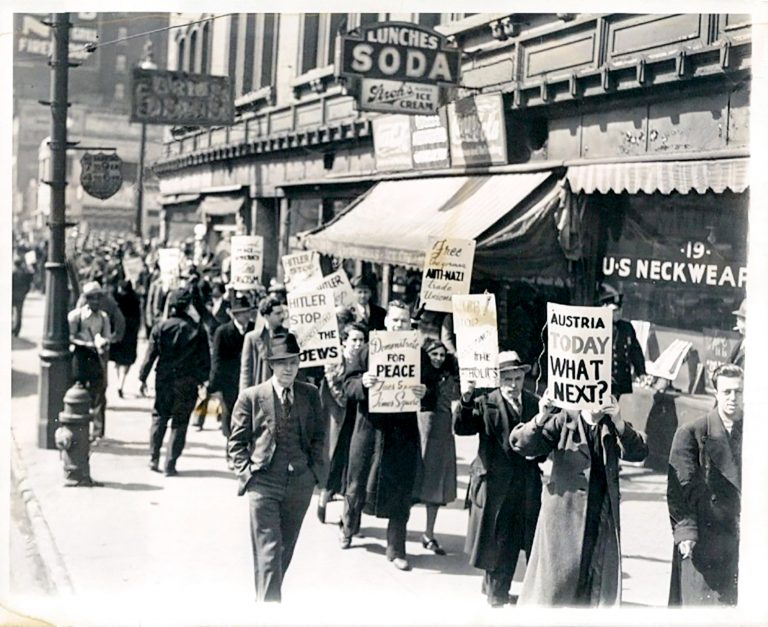
Anti-Nazi-Demonstration in Detroit, March 13, 1938
The “picket line” was originally developed by American labor unions as a legally permitted form of picketing during strikes. In Detroit, which is at this time still a thriving industrial metropolis, demonstrators use it to protest against the annexation of Austria and Hitler’s persecution of the Jews as well as to call for the release of the Nazi regime’s political prisoners and for peace.
ACME News Pictures / Zentrum für Antisemitismusforschung / Technische Universität Berlin
Anti-Nazi-Demonstration in Detroit, March 13, 1938
The “picket line” was originally developed by American labor unions as a legally permitted form of picketing during strikes. In Detroit, which is at this time still a thriving industrial metropolis, demonstrators use it to protest against the annexation of Austria and Hitler’s persecution of the Jews as well as to call for the release of the Nazi regime’s political prisoners and for peace.
ACME News Pictures / Zentrum für Antisemitismusforschung / Technische Universität Berlin
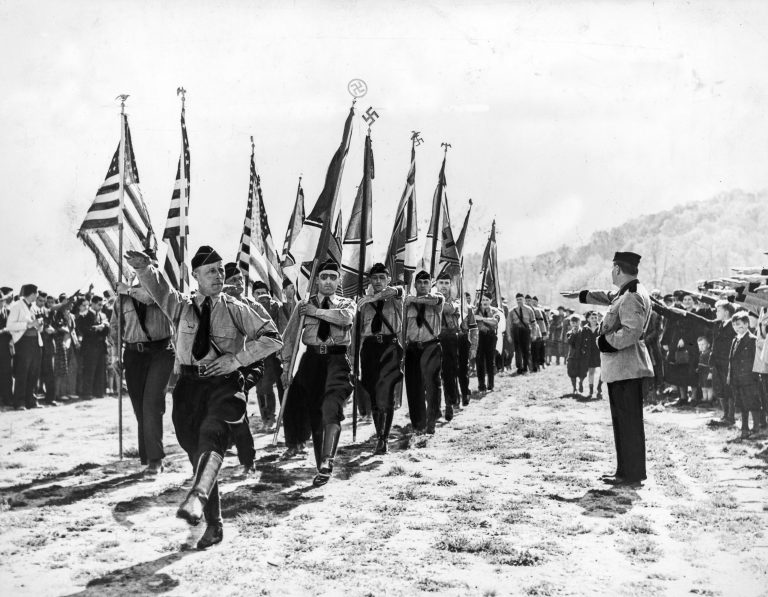
Inspection of a May Day parade at “Camp Nordland” in Andover, NJ, by Fritz Kuhn, the leader of the German-American Bund, May 1, 1938
The German-American Bund is established in 1936 as an organization of about 25,000 Americans of German ancestry. Its leader, Fritz Kuhn, who became a naturalized US citizen in 1934, declares the Jews to be the enemies of America and dubs President Roosevelt’s New Deal the “Jew Deal.” He quickly becomes the most famous antisemite in America. The Bund’s 8,000 “Storm Troopers” perpetrate brutal acts against Jews.
Bettmann Archive / Getty Images
Inspection of a May Day parade at “Camp Nordland” in Andover, NJ, by Fritz Kuhn, the leader of the German-American Bund, May 1, 1938
The German-American Bund is established in 1936 as an organization of about 25,000 Americans of German ancestry. Its leader, Fritz Kuhn, who became a naturalized US citizen in 1934, declares the Jews to be the enemies of America and dubs President Roosevelt’s New Deal the “Jew Deal.” He quickly becomes the most famous antisemite in America. The Bund’s 8,000 “Storm Troopers” perpetrate brutal acts against Jews.
Bettmann Archive / Getty Images
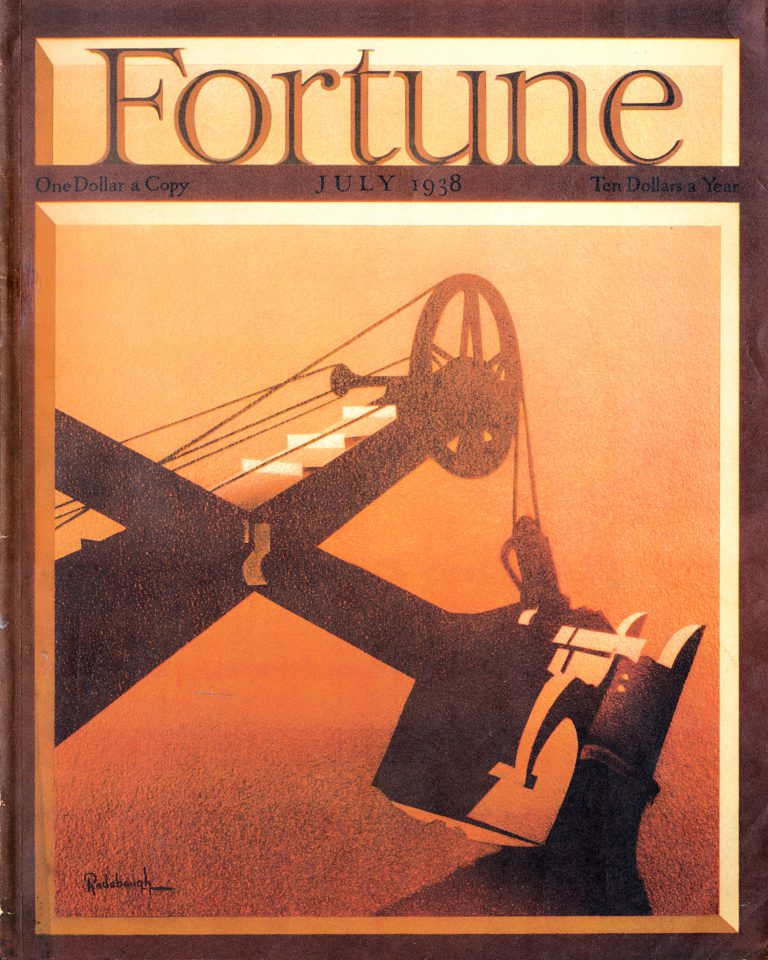
Fortune Magazine, July 1938
The 13th quarterly survey by Fortune Magazine, which is somewhat controversial in its methodology, shows that the country’s continued high level of approval for President Roosevelt and his policies is largely due to his overwhelming approval in the South. More Americans are concerned about the Japanese invasion of China than the annexation of Austria, and a cold welcome awaits refugees from Europe, with more than two thirds of those surveyed opposed to taking them in.
Time Inc., New York, NY
Fortune Magazine, July 1938
The 13th quarterly survey by Fortune Magazine, which is somewhat controversial in its methodology, shows that the country’s continued high level of approval for President Roosevelt and his policies is largely due to his overwhelming approval in the South. More Americans are concerned about the Japanese invasion of China than the annexation of Austria, and a cold welcome awaits refugees from Europe, with more than two thirds of those surveyed opposed to taking them in.
Time Inc., New York, NY
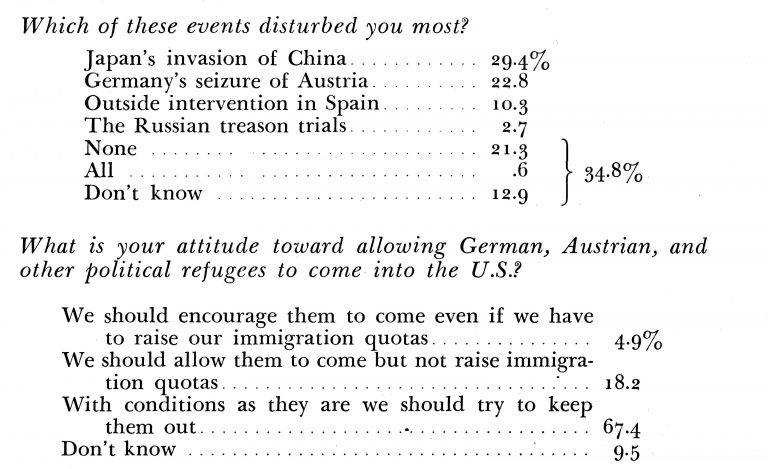
Fortune Quarterly Survey
The 13th quarterly survey by Fortune Magazine, which is somewhat controversial in its methodology, shows that the country’s continued high level of approval for President Roosevelt and his policies is largely due to his overwhelming approval in the South. More Americans are concerned about the Japanese invasion of China than the annexation of Austria, and a cold welcome awaits refugees from Europe, with more than two thirds of those surveyed opposed to taking them in.
Time Inc., New York, NY
Fortune Quarterly Survey
The 13th quarterly survey by Fortune Magazine, which is somewhat controversial in its methodology, shows that the country’s continued high level of approval for President Roosevelt and his policies is largely due to his overwhelming approval in the South. More Americans are concerned about the Japanese invasion of China than the annexation of Austria, and a cold welcome awaits refugees from Europe, with more than two thirds of those surveyed opposed to taking them in.
Time Inc., New York, NY
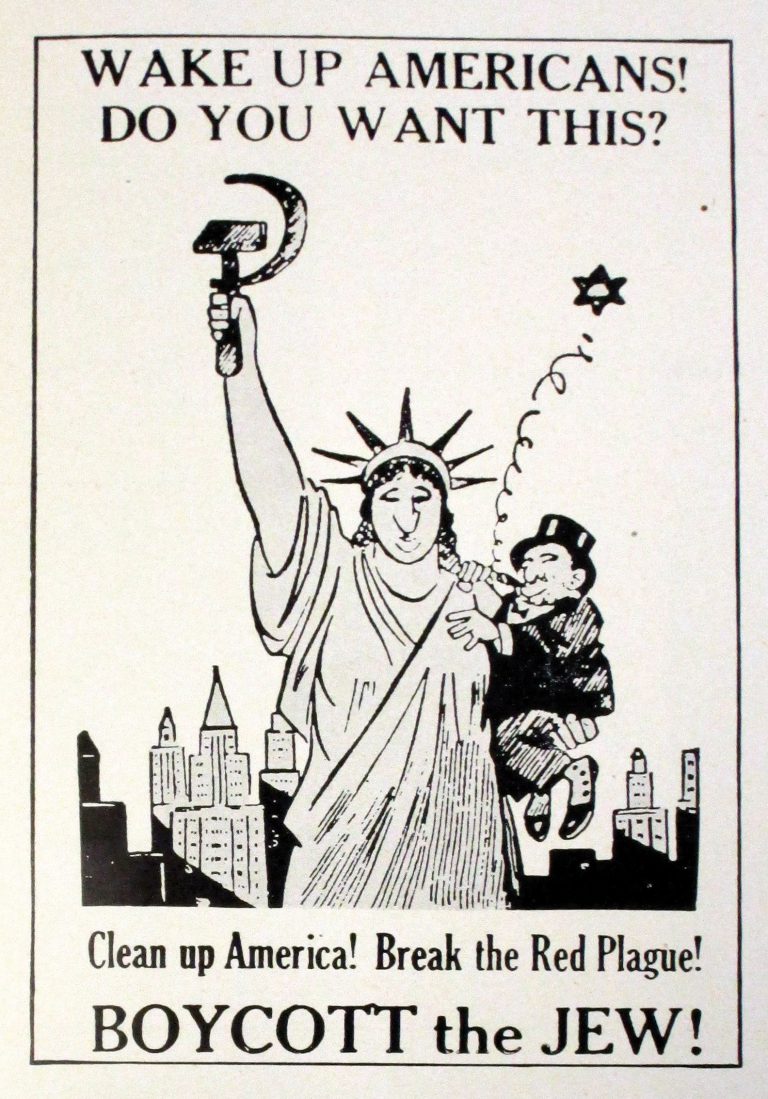
Antisemitic stickers that were put on Jewish-owned stores in Portland, Oregon, on June 26, 1938
Fascist, racist and antisemitic groups are also active outside of the German-American population. In his radio address, the Catholic priest Charles Edward Coughlin attacks Jews as “Christ-killers” and blames them for capitalism, liberalism and communism. His Christian Front works together with the Bund and stockpiles firearms to attack Jewish establishments.
Photo: Don Robinson / Life, July 11, 1938
Antisemitic stickers that were put on Jewish-owned stores in Portland, Oregon, on June 26, 1938
Fascist, racist and antisemitic groups are also active outside of the German-American population. In his radio address, the Catholic priest Charles Edward Coughlin attacks Jews as “Christ-killers” and blames them for capitalism, liberalism and communism. His Christian Front works together with the Bund and stockpiles firearms to attack Jewish establishments.
Photo: Don Robinson / Life, July 11, 1938
![Dorothy Thompson after a reception with President Roosevelt in front of the White House, May 29, 1940 Journalist Dorothy Thompson begins working as a correspondent in Berlin in 1924. In 1932 she interviews Hitler and in 1934 she is expelled from Germany. Her column in the New York Herald Tribune, “On the Record,” and her radio commentary on NBC reach an audience of millions. In 1939, Time Magazine declares her the most influential woman in America after First Lady Eleanor Roosevelt. Harris & Ewing / Library of Congress, Washington, DC, Prints & Photographs Division, LC-H22-D- 9106 [P&P]](https://evian1938.de/files/dorothy-2-768x950.jpg)
Dorothy Thompson after a reception with President Roosevelt in front of the White House, May 29, 1940
Journalist Dorothy Thompson begins working as a correspondent in Berlin in 1924. In 1932 she interviews Hitler and in 1934 she is expelled from Germany. Her column in the New York Herald Tribune, “On the Record,” and her radio commentary on NBC reach an audience of millions. In 1939, Time Magazine declares her the most influential woman in America after First Lady Eleanor Roosevelt.
Harris & Ewing / Library of Congress, Washington, DC, Prints & Photographs Division, LC-H22-D- 9106 [P&P]
Dorothy Thompson after a reception with President Roosevelt in front of the White House, May 29, 1940
Journalist Dorothy Thompson begins working as a correspondent in Berlin in 1924. In 1932 she interviews Hitler and in 1934 she is expelled from Germany. Her column in the New York Herald Tribune, “On the Record,” and her radio commentary on NBC reach an audience of millions. In 1939, Time Magazine declares her the most influential woman in America after First Lady Eleanor Roosevelt.
Harris & Ewing / Library of Congress, Washington, DC, Prints & Photographs Division, LC-H22-D- 9106 [P&P]
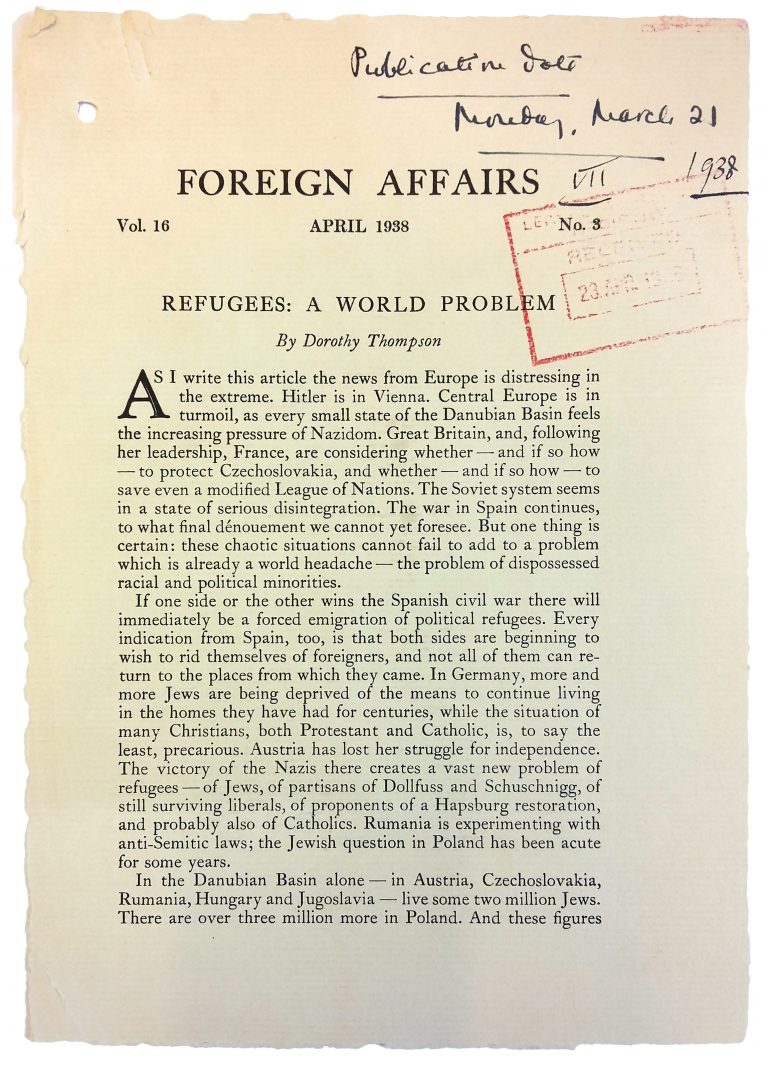
Foreign Affairs, April 1938
Dorothy Thompson advocates for Austrian refugees to be taken in. In the middle of March 1938, she sends a galley of her article “Refugees – a World Problem” to US Secretary of State Cordell Hull. The discussion that this triggers in the Roosevelt administration ultimately leads to the decision to create a new intergovernmental organization at an international conference to find a solution to the refugee problem.
United Nations Archives, Genf
Foreign Affairs, April 1938
Dorothy Thompson advocates for Austrian refugees to be taken in. In the middle of March 1938, she sends a galley of her article “Refugees – a World Problem” to US Secretary of State Cordell Hull. The discussion that this triggers in the Roosevelt administration ultimately leads to the decision to create a new intergovernmental organization at an international conference to find a solution to the refugee problem.
United Nations Archives, Genf
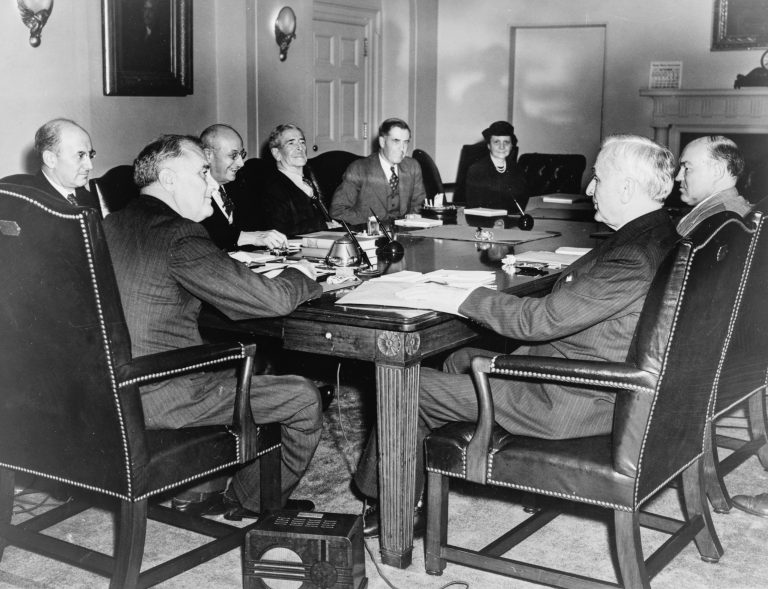
Emergency meeting of Roosevelt’s cabinet, 1938
The photo shows President Franklin D. Roosevelt (2nd from left) with (clockwise) Secretary of the Treasury Henry Morgenthau, Attorney General Homer Cummings, Secretary of the Navy Claude A. Swanson, Secretary of Agriculture Henry A. Wallace, Secretary of Labor Frances Perkins, Secretary of War Harry Woodring and Secretary of State Cordell Hull.
Bettmann Archive / Getty Images
Emergency meeting of Roosevelt’s cabinet, 1938
The photo shows President Franklin D. Roosevelt (2nd from left) with (clockwise) Secretary of the Treasury Henry Morgenthau, Attorney General Homer Cummings, Secretary of the Navy Claude A. Swanson, Secretary of Agriculture Henry A. Wallace, Secretary of Labor Frances Perkins, Secretary of War Harry Woodring and Secretary of State Cordell Hull.
Bettmann Archive / Getty Images





![Dorothy Thompson after a reception with President Roosevelt in front of the White House, May 29, 1940 Journalist Dorothy Thompson begins working as a correspondent in Berlin in 1924. In 1932 she interviews Hitler and in 1934 she is expelled from Germany. Her column in the New York Herald Tribune, “On the Record,” and her radio commentary on NBC reach an audience of millions. In 1939, Time Magazine declares her the most influential woman in America after First Lady Eleanor Roosevelt. Harris & Ewing / Library of Congress, Washington, DC, Prints & Photographs Division, LC-H22-D- 9106 [P&P]](https://evian1938.de/files/dorothy-2.jpg)

